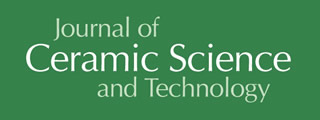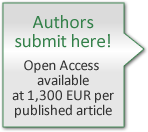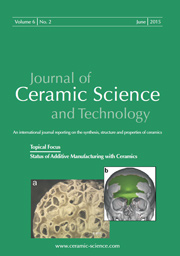Articles
All articles | Recent articles
Statistical Optimization of the Binder Mixing Ratio for Fabricating Reliable Ceramic Raschig Rings
A. Salem, Y. Beygi Khosrowshahi, S. Aghahosseini
Mineral Processing Research Center, Chemical Engineering Department, Sahand University of Technology, Tabriz, Iran
received March 20, 2011, received in revised form April 28, 2011, accepted May 31, 2011
Vol. 2, No. 3, Pages 159-168 DOI: 10.4416/JCST2011-00013
Abstract
Several types of ceramic Raschig rings have been developed for extreme chemical and waste treatment processes. The compressive strength and reliability of ceramic Raschig rings are basically affected by the mixing ratio of the materials used and the quality control of the shaping process. To optimize the above-mentioned properties, various experiments have been conducted. In the present investigation polyvinyl alcohol, carboxymethyl cellulose and Arabic gum were selected and used in an experimental design algorithm. Different amounts of binders were added to a typical kaolin under conditions similar to those found in industrial practice. Different combinations of clay and binders were prepared according to the mixture design algorithm and shaped with the extrusion technique. The test rings were sintered at 1270 ºC and characterized by determining their linear shrinkage, water absorption, porosity and compressive strength. The strength data were statistically analyzed based on the Weibull theory to mathematically describe the reliability of the rings. Regression models were calculated for correlating the above properties in order to optimize the binder mixing ratio. The suitable amounts of binders were reported and the variation in the Weibull modulus was confirmed by means of scanning electron microscopy.
![]() Download Full Article (PDF)
Download Full Article (PDF)
Keywords
Raschig ring, extrusion, compressive strength, reliability.
References
1 Carty, W.M., Senapti, U.: Porcelain raw materials, processing, phase evolution and mechanical behavior, J. Am. Ceram. Soc., 81 [1], 3 – 20, (1998).
2 Reed, J.S.: Principle of ceramic processing. 2nd edition., John Wiley & Sons, Inc., New York, (1995).
3 Salehi, M., Salem, A.: Influence of sintering temperature on microstructure changes of ceramic raschig ring, Korean J. Chem. Eng., 26 [2], 500 – 505, (2009).
4 Zhao, S.K., Huang, Y., Guo, J.K.: Sinterability of ZrSiO4/Al2O3 mixed powders, J. Ceram. Int., 29, 49 – 53, (2003).
5 Esposito, L., Salem, A., Tucci, A., Gualtieri, A., Jazayeri, S.H.: The use of nepheline-syenite in body mix for porcelain stoneware tiles, Ceram. Int., 31, 233 – 240, (2005).
6 Harada, R., Sugiyama, N., Ishida, H.: Al2O3-Strengthened feldspathic porcelain bodies: effect of the amount and particle size of alumina, Ceram. Eng. Sci. Proc., 17 [1], 88 – 98, (1996).
7 Shirchi, S., Salem, A., Jazayeri, S.H.: The effects of alumina and zirconium silicate on reliability of ceramic packing, in Proceedings of the 2nd International Congress on Ceramics, Verona, (2008).
8 Villora, J.M., Callejas, P., Barba, M.F., Baudın, C.: Statistical analysis of the fracture behavior of porous ceramic raschig ring, J. Eur. Ceram. Soc., 24, 589 – 94, (2004).
9 Salehi, M., Salem, A.: Effect of moisture content on extrusion process of kaolinitic-illitic clay in manufacturing of ceramic raschig ring, J. Mater. Process. Tech., 200, 232 – 237, (2008).
10 Mukhopadhyay, T.K., Das, M., Ghosh, S., Chakrabarti, S., Ghatak, S.: Microstructure and thermomechanical properties of talc doped stoneware composition containing illitic clay, Ceram. Int., 25, 587 – 597, (2003).
11 Klein, J.: Application of feldspar raw materials in the silicate ceramics industry, Ceram. Int., 50, [2], 86 – 94, (2001).
12 Rostami, N., Salem, A., Jazayeri, S.H.: The effect of nepheline syenite on reliability of extruded ceramic raschig rings, in Proceedings of the 2nd International Congress on Ceramics, Verona, (2008).
13 Lee, K.C., Her, J.H., Kwon, S.K.: Red clay composites reinforced with polymeric binders, Constr. Build. Mater., 22, 2292 – 2298, (2008).
14 Beygi Khosrowshahi, Y., Salem A.: A view on organic binder effects on technical properties of ceramic raschig rings, Bol. Soc. Esp. Ceram. V., 49, [5], 221 – 228, (2010).
15 Romagnoli, M., Andreola, F.: Mixture of deflocculants: a, systematic approach, J. Eur. Ceram. Soc., 27, 1871 – 1874, (2006).
16 Correia, S.L., Hotza, D., Segadaes, A.M.: Simultaneous optimization of linear firing shrinkage and water absorption of triaxial ceramic bodies using experimental design, Ceram. Int., 30, 917 – 922, (2004).
17 Menezes, R.R., Malzac Neto, H.G., Santana, L.N.L., Lira, H.L., Ferreira, H.S., Neves, G.A.: Optimization of waste content in ceramic tiles using statistical design of mixture experiments, J. Eur. Ceram. Soc., 28, 3027 – 3039, (2008).
18 Cornell, J.A.: Experiments with mixtures: Designs, models, and the analysis of mixture data. John Wiley & Sons, Inc., New York, (1990).
19 ASTM C373: Standard test method for water absorption, bulk density, apparent porosity and apparent specific gravity of fired whiteware products. Annual Book of ASTM Standards, (2006).
20 PrEN 623 – 2: Methods of testing advanced technical ceramics general and textural properties, Part 2: Determination of density and porosity. Annual Book of European Standards, (1991).
21 Salehi, M., Salem, A.: Influence of sintering condition on strength reliability of ceramic raschig rings shaped by extrusion process, in Proceedings of the Material Processing for Properties and Performance Conference (MP3), Singapore, 5, 82 – 184, (2006).
22 ASTM Standard C1239, Standard practice for reporting uniaxial strength data estimating weibull distribution parameters for advance ceramics, ASTM International, West Conshohocken, PA, (2001).
Copyright
Göller Verlag GmbH


